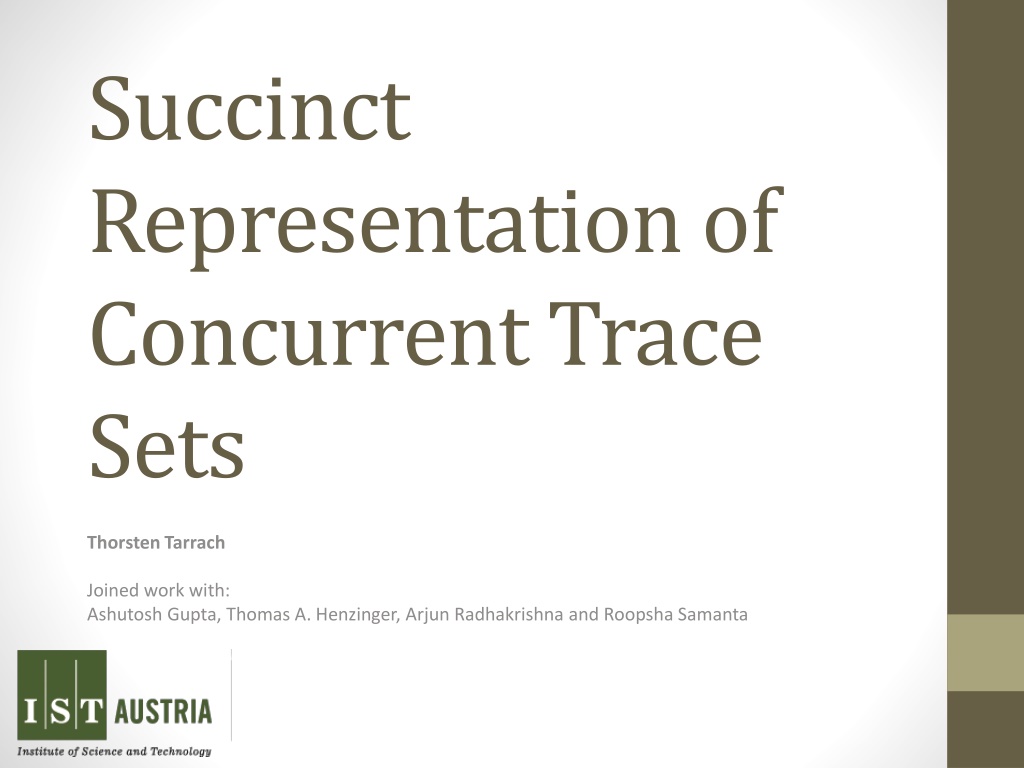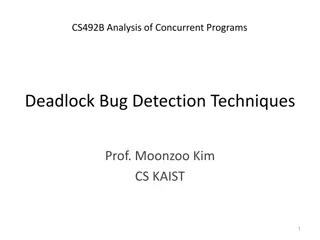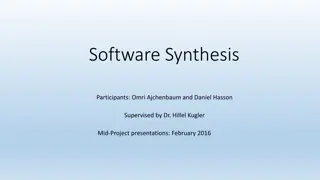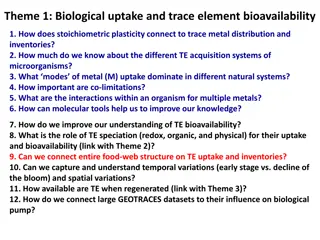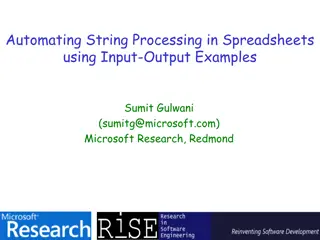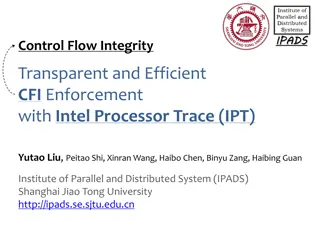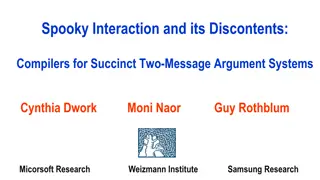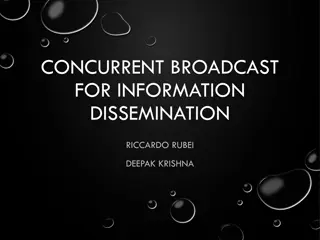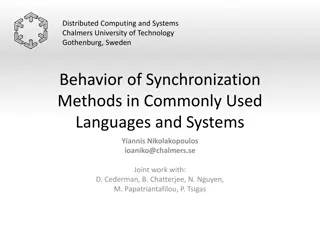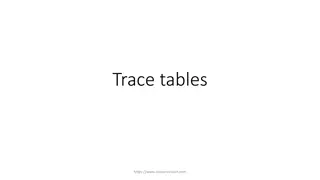Succinct Representation of Concurrent Trace Sets in Program Synthesis
This work focuses on representing concurrent trace sets efficiently in program synthesis. It addresses the problem setting of concurrent programs with specifications and provides solutions for avoiding assertion violations, including adding locks, barriers, and wait-notifies. The synthesis loop ensures correct program output without faulty traces, as demonstrated through examples and comparisons of previous methods.
Download Presentation

Please find below an Image/Link to download the presentation.
The content on the website is provided AS IS for your information and personal use only. It may not be sold, licensed, or shared on other websites without obtaining consent from the author. Download presentation by click this link. If you encounter any issues during the download, it is possible that the publisher has removed the file from their server.
E N D
Presentation Transcript
Succinct Representation of Concurrent Trace Sets Thorsten Tarrach Joined work with: Ashutosh Gupta, Thomas A. Henzinger, Arjun Radhakrishna and Roopsha Samanta
Problem setting Input: Concurrent program with specification (assertions) No assertion violated in preemption-free execution Assertion is violated in concurrent execution Output: Modified program where no assertion is ever violated Add locks Barriers Wait-notifies (Reorderings)
Synthesis loop Input program Program Model checker yes correct Synthesis Output program no Faulty trace
Example: Programs and traces Bad execution Bad trace Program withdrawal = 1, deposit = 1 x=balance=0, deposited=0, withdrawn=0 W1: t1 := balance t1 = 0 D1: t2 := balance t2 = 0 W2: balance := t1 withdrawal balance = -1 W3: withdrawn := 1 widthdrawn = 1 D2: balance := t2 + deposit balance = 1 D3: deposited := 1 deposited = 1 C1: assume(deposited=1 withdrawn=1) C2: assert(balance = x+deposit-withdrawal) init: x = balance, deposited=0, withdrawn=0 thread_withdraw W1: t1 := balance W2: balance := t1 withdrawal W3: withdrawn := 1 thread_deposit D1: t2 := balance D2: balance := t2 + deposit D3: deposited := 1 thread_check C1: assume(deposited=1 withdrawn=1) C2: assert(balance = x+deposit -withdrawal)
Previous method Program Total order init: x = balance, deposited=0, withdrawn=0 W1 D1 thread_withdraw W1: t1 := balance W2: balance := t1 withdrawal W3: withdrawn := 1 W2 D2 thread_deposit D1: t2 := balance D2: balance := t2 + deposit D3: deposited := 1 W3 D3 thread_check C1: assume(deposited=1 withdrawn=1) C2: assert(balance = x+deposit -withdrawal)
Previous method Program Partial order init: x = balance, deposited=0, withdrawn=0 W1 D1 thread_withdraw W1: t1 := balance W2: balance := t1 withdrawal W3: withdrawn := 1 W2 D2 thread_deposit D1: t2 := balance D2: balance := t2 + deposit D3: deposited := 1 W3 D3 thread_check C1: assume(deposited=1 withdrawn=1) C2: assert(balance = x+deposit -withdrawal)
Previous method Program Bad trace W1: t1 := balance D1: t2 := balance W2: balance := t1 withdrawal W3: withdrawn := 1 D2: balance := t2 + deposit D3: deposited := 1 A1: y = 1 B1: y = 3 A2: y = 2 C1: assume(deposited=1 withdrawn=1) C2: assert(balance = x+deposit-withdrawal) init: x = balance, deposited=0, withdrawn=0 thread_withdraw W1: t1 := balance W2: balance := t1 withdrawal W3: withdrawn := 1 thread_deposit D1: t2 := balance D2: balance := t2 + deposit D3: deposited := 1 thread_check C1: assume(deposited=1 withdrawn=1) C2: assert(balance = x+deposit-withdrawal) A1 B1 thread_1 A1: y = 1 A2: y = 2 A2 thread_2 B1: y = 3
Previous method Program Partial order init: x = balance, deposited=0, withdrawn=0 A1 B1 W1 D1 thread_withdraw W1: t1 := balance W2: balance := t1 withdrawal W3: withdrawn := 1 A2 W2 D2 thread_deposit D1: t2 := balance D2: balance := t2 + deposit D3: deposited := 1 W3 D3 thread_check C1: assume(deposited=1 withdrawn=1) C2: assert(balance = x+deposit-withdrawal) thread_1 A1: y = 1 A2: y = 2 thread_2 B1: y = 3
Trace separation Input: Single faulty trace (from a model checker etc.) Output: Happens-before formula, describing all bad traces in the neighbourhood Applications for Happens-before formulae Synthesis Fault localisation & characterisation Improving CEGAR loop
Example: Programs and traces Program Traces init: x = balance, deposited=0, withdrawn=0 Infeasible traces thread_withdraw W1: t1 := balance W2: balance := t1 withdrawal W3: withdrawn := 1 Good traces thread_deposit D1: t2 := balance D2: balance := t2 + deposit D3: deposited := 1 Bad traces thread_check C1: assume(deposited=1 withdrawn=1) C2: assert(balance = x+deposit -withdrawal)
Example: Programs and traces Program Formulas Exact representation of bad traces: hb(W1,D2) hb(D1,W2) hb(W3,C1) hb(D3,C1) init: x = balance, deposited=0, withdrawn=0 thread_withdraw W1: t1 := balance W2: balance := t1 withdrawal W3: withdrawn := 1 W1 D1 thread_deposit D1: t2 := balance D2: balance := t2 + deposit D3: deposited := 1 W2 D2 W3 D3 thread_check C1: assume(deposited=1 withdrawn=1) C2: assert(balance = x+deposit-withdrawal) C1 C2
Example: Programs and traces Program Formulas Sound overapproximation of bad traces: hb(W1,D2) hb(D1,W2) init: x = balance, deposited=0, withdrawn=0 thread_withdraw W1: t1 := balance W2: balance := t1 withdrawal W3: withdrawn := 1 W1 C1 D1 C2 thread_deposit D1: t2 := balance D2: balance := t2 + deposit D3: deposited := 1 W2 D2 W3 D3 thread_check C1: assume(deposited=1 withdrawn=1) C2: assert(balance = x+deposit-withdrawal)
Example: Programs and traces Program Formulas Exact representation of good traces: (hb(D2,W1) hb(W2,D1)) hb(W3,C1) hb(D3,C1) init: x = balance, deposited=0, withdrawn=0 thread_withdraw W1: t1 := balance W2: balance := t1 withdrawal W3: withdrawn := 1 W1 D1 or thread_deposit D1: t2 := balance D2: balance := t2 + deposit D3: deposited := 1 W2 D2 W3 D3 thread_check C1: assume(deposited=1 withdrawn=1) C2: assert(balance = x+deposit-withdrawal) C1 C2
Example: Programs and traces Program Formulas Sound overapproximation of good traces: hb(D2,W1) hb(W2,D1) init: x = balance, deposited=0, withdrawn=0 thread_withdraw W1: t1 := balance W2: balance := t1 withdrawal W3: withdrawn := 1 W1 C1 D1 or C2 thread_deposit D1: t2 := balance D2: balance := t2 + deposit D3: deposited := 1 W2 D2 W3 D3 thread_check C1: assume(deposited=1 withdrawn=1) C2: assert(balance = x+deposit-withdrawal)
Exact Algorithm ??? ?? ????? while satisfiable V partial satisfying assignment (model) of ?? ?? ? ?,? |? ?(?,? ) ?? return?? This basically enumerates all bad traces [1] C. Wang, S. Kundu, M. Ganai, and A. Gupta. Symbolic predictive analysis for concurrent programs. In FM, pages 256 272. 2009
Approximation Algorithm ??? ?? ????? while satisfiable ? data-flow dependencies in model of ??? ?????_????(????: ? ?,? |? ?(?,? ) , ????:? ????? ? ???) ?? ?? ??? ?? return??
Unsat core optimisation Program Partial order init: x = balance, deposited=0, withdrawn=0 A1 B1 W1 D1 thread_withdraw W1: t1 := balance W2: balance := t1 withdrawal W3: withdrawn := 1 A2 W2 D2 thread_deposit D1: t2 := balance D2: balance := t2 + deposit D3: deposited := 1 W3 D3 thread_check C1: assume(deposited=1 withdrawn=1) C2: assert(balance = x+deposit-withdrawal) thread_1 A1: y = 1 A2: y = 2 thread_2 B1: y = 3
Application: Synthesis We can infer locks, barriers and wait-notifies Use formula of good traces Bring into CNF For each conjunct Apply rewrite rules Xi Yk or Xj Yl
Synthesis Example Program Formulas Sound overapproximation of good traces: hb(D2,W1) hb(W2,D1) init: x = balance, deposited=0, withdrawn=0 thread_withdraw W1: t1 := balance W2: balance := t1 withdrawal W3: withdrawn := 1 thread_deposit D1: t2 := balance D2: balance := t2 + deposit D3: deposited := 1 W1 D1 or W2 D2 thread_check C1: assume(deposited=1 withdrawn=1) C2: assert(balance = x+deposit-withdrawal) W3 D3
Application: Bug summarisation We can detect data race bugs atomicity violation define-use bugs two stage access bugs We use the DNF of bad traces read(v) read(v) l1 l2 write(v) write(v) l1 l2
Bug summarisation example Program Formulas Sound overapproximation of bad traces: hb(W1,D2) hb(D1,W2) init: x = balance, deposited=0, withdrawn=0 thread_withdraw W1: t1 := balance W2: balance := t1 withdrawal W3: withdrawn := 1 read(bal) read(bal) W1 D1 write(bal) write(bal) thread_deposit D1: t2 := balance D2: balance := t2 + deposit D3: deposited := 1 W2 D2 W3 D3 thread_check C1: assume(deposited=1 withdrawn=1) C2: assert(balance = x+deposit-withdrawal) data-race bug
Application CEGAR acceleration
Summary A method and a tool to obtain succinct representations of trace neighbourhoods Captures the reason for the error Three applications Synthesis Bug summarisation CEGAR acceleration
